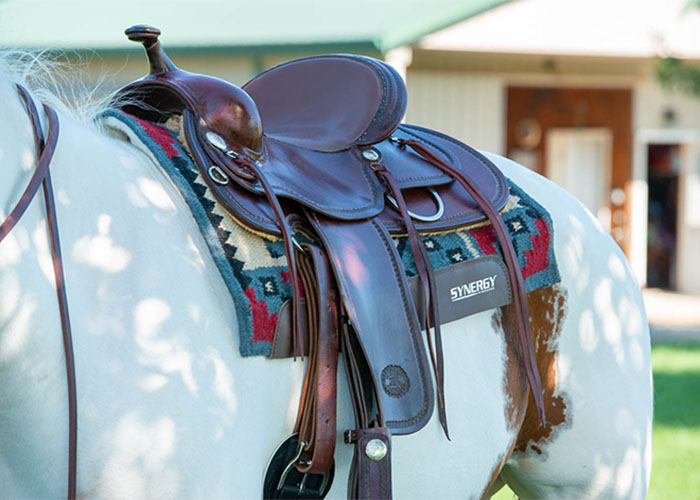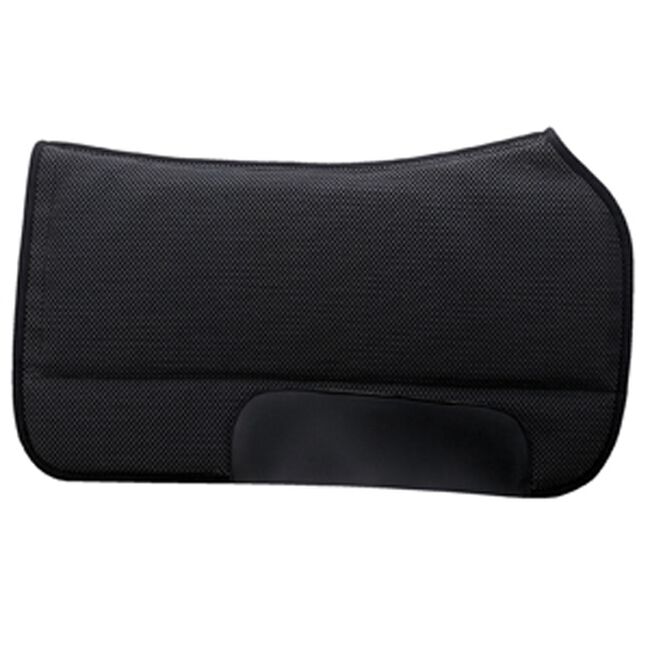
Your saddle pad is an important piece of tack that will assist in keeping your horse comfortable for the duration of your ride. It cushions your horse’s back while protecting the saddle from sweat, horsehair, and dirt. Additionally, some saddle pads help to improve saddle fit with specialized designs or provide supplementary support for sore-backed horses and horses with extremely sensitive backs. With a wide array of shapes, styles, and materials available, there are many options when it comes to choosing the right saddle pad for your horse.
When shopping for a Western saddle pad, there are many things to take into consideration. In this blog post, we explore the various types of saddle pads, their uses, and their potential benefits for your horse. Learn more about English saddle pad options on our blog post, Specialized Saddle Pads for the English Rider.
Shapes
There are several different shapes of Western saddle pads, each with a different purpose. When choosing the shape of the saddle pad, it is important to think about not only what you will be doing with your horse, but also your horse’s unique conformational characteristics.
Straight Pads are perhaps the most commonly used western pad. They are simple, square pads (with no contouring or extra shaping), which fold in half over your horse’s back. Due to their shape, they are best suited for horses with normal backs or horses with mutton withers (minimal withers).
Round Pads, also referred to as barrel pads, are designed for horses with shorter backs or short coupling. They have rounded edges, which helps to prevent the saddle pad from interfering with your horse’s movement.
Contour Pads are shaped to mimic the horse’s back and topline, providing ample room for the withers and spine. They can help to balance the saddle and, in many cases, improve the fit of the saddle by eliminating pressure points. This anatomical design is popular among many equestrians.
Cutout Pads or cut back pads resemble straight pads or round pads; however, they feature an anatomical cutout of the pad material over the withers. This allows extra space for horses with high withers, while reducing the amount of pressure that is placed on the withers.
Specialized Styles
In addition to various shapes, there are also a number of specialized Western saddle pads that are designed to increase your horse’s comfort and performance under saddle.
Therapeutic Pads feature innovative fabrics that help to reduce pain, inflammation, and tension in your horse’s back muscles to improve their overall comfort and performance under saddle. They are popular for senior horses as well as high-performance horses with a heavy workload. Close density foam and gel pads minimize the concussion on your horse’s back.
Shim Pads or corrective pads allow you to customize the fit of your saddle by using removable shims within the saddle pad in specialized pockets. When correctly adjusted, they can accommodate many saddle fit issues, including bridging, asymmetry in the horse’s back, and an unbalanced saddle. Read all about one of our employee’s successes using a shim pad on her mare with a sway back on our blog post, Reinsman Multi-Fit Trail Pad Review.
Non-Slip Pads are ideal for horses with minimal withers or a round shape over their back. By utilizing tacky materials that cling to your horse’s coat, often neoprene or soft polymer (PVC) coated mesh, they help keep the saddle properly positioned and prevent it from sliding out of place. Many non-slip pads, like the Weaver GettaGrip Saddle Pad, showcase perforations in the material, which provides ventilation as well.
Weaver GettaGrip Saddle Pad
This non-slip, easy care black neoprene saddle pad provides ventilation and quick drying.
Wither Relief Pads, also referred to as built-up pads, provide cushioning and support on either side of the wither area to lift the saddle off this ridge between the shoulder blades (many times they feature wither cut outs as well). These pads are great for horses with high withers or shark fin withers because they help to prevent pressure points and rubs. For horses with asymmetrical conformation, look for a wither relief pad with shims to improve the fit of your saddle and the overall comfort of your horse.
Bridge Pads are designed for horses that are wearing a saddle that gapes or ‘bridges’ along the middle/sides of the back. With specialized padding, it ensures that the saddle makes contact and applies consistent pressure on the musculature for improved saddle fit.
Every horse is an individual. When purchasing a saddle pad, consider their personalized needs based on their conformation, workload, and saddle fit. There truly are many choices and solutions when it comes to purchasing the best fitting Western saddle pad for your horse.
If you have any questions regarding the saddle pads that we carry or would like assistance choosing the most appropriate Western pad for your horse, we encourage you to speak to a member of our friendly and knowledgeable sales staff.


I just bought a saddle and it was fitted to my horse. The saddle maker came to my horse and tried several different tree’s on him before making the saddle. I don’t know how to pick the right pad for the new saddle. I know the one I have now is too large. Do you have any suggestions?
JIll
Selecting the right Western Pad for your saddle can be tricky. Generally, you need the pad to be thick enough to cushion the back, yet thin enough that the tree does not pinch your horse’s withers, back, or shoulders. We recommended starting with a general all-purpose pad and then assessing the fit. This will allow you to determine if you need a thicker or thinner pad. Also, you may want to work with your saddle maker and saddle fitter to determine the optimal pad for your horse.